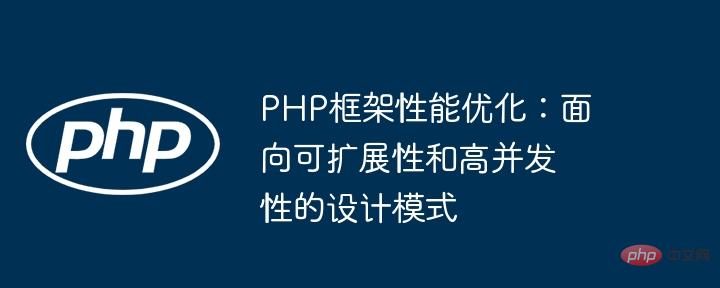Home >Backend Development >PHP Tutorial >PHP framework performance optimization: design patterns for scalability and high concurrency
PHP framework performance optimization: design patterns for scalability and high concurrency
- WBOYWBOYWBOYWBOYWBOYWBOYWBOYWBOYWBOYWBOYWBOYWBOYWBOriginal
- 2024-06-05 21:17:001310browse
PHP framework performance optimization: scalability-oriented: layered architecture, cache, NoSQL database. For high concurrency: asynchronous programming, horizontal scaling, queue systems.

PHP framework performance optimization: design pattern for scalability and high concurrency
In order to meet the growing web applications Program requirements, performance optimization of the PHP framework are crucial. By adopting specific design patterns, we can improve an application's scalability and ability to handle requests under high concurrency situations.
Design patterns for scalability
- Layered architecture: Decompose application logic into different layers, such as views layer, model layer, and controller layer to improve maintainability and reusability.
- Caching: Improving performance by storing common data and page fragments in memory, reducing database query and page load times.
- NoSQL database: Using a NoSQL database, such as MongoDB or Redis, to process non-relational data can improve scalability, especially when processing massive amounts of data.
Design patterns for high concurrency
- Asynchronous programming: Use asynchronous programming techniques such as coroutines or events Driver programming can handle multiple requests at the same time instead of waiting for each request to complete.
- Horizontal expansion: By increasing the number of application servers and achieving load balancing, high concurrent requests can be distributed to multiple machines, thereby improving processing capabilities.
- Queue system: Using a queue system, such as RabbitMQ or Kafka, can process requests in order and alleviate the impact of high concurrent requests on the system.
Practical Case
Let us consider an e-commerce application built using the Laravel framework. We can adopt the following extensibility-oriented design patterns:
- Divide models, controllers and views using different namespaces.
- Use Redis to cache recently viewed products and shopping cart items.
- Store user and order data in a MySQL database.
In order to improve high concurrency performance, we can apply the following design patterns:
- Use Laravel's coroutine queue to handle incoming requests.
- Use a load balancer to distribute traffic to multiple servers.
- Use RabbitMQ queue to handle order processing tasks.
Conclusion
By adopting design patterns for scalability and high concurrency, we can achieve better performance in the PHP framework. Layered architectures, caching, NoSQL databases, asynchronous programming, horizontal scaling, and queuing systems are critical to optimizing applications to handle high load requests.
By following these patterns, we can create PHP applications that are scalable, highly concurrent, and meet the needs of modern web applications.
The above is the detailed content of PHP framework performance optimization: design patterns for scalability and high concurrency. For more information, please follow other related articles on the PHP Chinese website!

